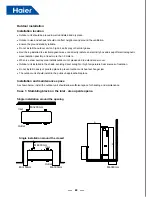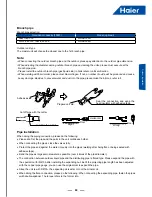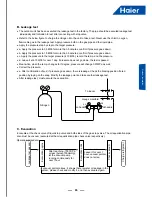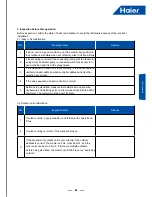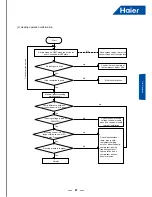
35
35
Outdoor Installation
Operation procedure:
B. Leakage test
■
The outdoor unit has been executed the leakage test in the factory. The pipe should be executed leakage test
individually and forbidden to test after connecting with stop valve.
■
Refer to the below figure to charge the nitrogen into the unit to take a test. Never use the chlorin, oxygen,
flammable gas in the leakage test. Apply pressure both on the gas pipe and the liquid pipe.
■
Apply the pressure step by step to the target pressure.
■
a. Apply the pressure to 0.5MPa for more than 5 minutes, confirm if pressure goes down.
■
b. Apply the pressure to 1.5MPa for more than 5 minutes, confirm if pressure goes down.
■
c. Apply the pressure to the target pressure (4.15MPa), record the temp. and the pressure.
■
d. Leave it at 4.15MPa for over 1 day, if pressure does not go down, the test is passed.
■
Meanwhile, when the temp. changes for 1degree, pressure will change 0.01MPa as well.
■
Correct the pressure.
■
e. After confirmation of a~d, if pressure goes down, there is leakage. Check the brazing position, flared
position by laying on the soap. Modify the leakage point and take another leakage test.
■
After leakage test, must execute the evacuation.
C. Evacuation
Evacuate at the check valve of liquid stop valve and both sides of the gas stop valve. The oil equalization pipe
also must be vacuum (executed at the oil equalization pipe check valve respectively).
Nitrogen
To indoor
Gauge manifold
Lo
Hi
Lo handle
Hi handle
Leakage test passed
Evacuation begins
Evacuation ends
Check vacuum
Charge refrigerant
After reaching -100.7KPa
or less (below-755mmHg),
let the vacuum pump
running continuously for
over 1hour.
Leave it for over 1
hour, vacuum pointer
does not arise.
If vacuum pointer arises, it shows there is water or leakage in the
system, please check and modify it, and then evacuate again.


